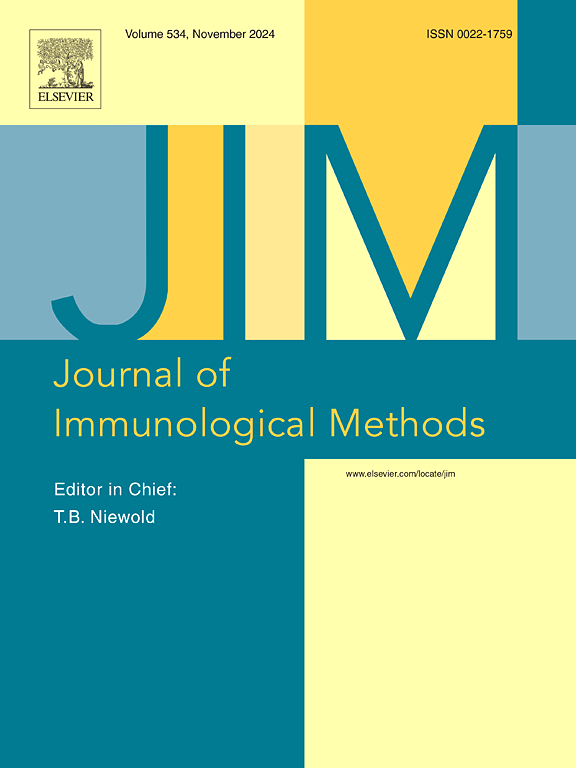使用功能失调T细胞进行表型筛选免疫检查点调节剂的高通量测定
IF 1.6
4区 医学
Q4 BIOCHEMICAL RESEARCH METHODS
引用次数: 0
摘要
在对病毒感染或肿瘤发生的长期反应中,效应T细胞持续受到刺激并变得功能失调。功能失调的T细胞过度表达抑制调节因子,表现出效应细胞因子产生减少,并失去强大的效应功能,导致抗原/癌症消除失败。在本研究中,我们建立了一种从人外周血单个核细胞(PBMCs)中产生功能失调T细胞的方法,并开发了一种全自动384孔高通量测定方法来评估免疫检查点调节剂。具体来说,通过白细胞介素-2 (IL-2)和Phaseolus Vulgaris白细胞凝集素(PHA-L)来维持PBMCs,诱导功能失调的T细胞。随后使用流式细胞术检测和定量细胞群,并使用经过验证的T细胞进行进一步的检测开发。为了评估化合物的活性,将细胞与测试化合物预孵育24小时,然后用抗cd3和抗cd28刺激。然后收集细胞上清液用于细胞因子测量(例如,IL-2和干扰素γ (IFN-γ)),使用AlphaLISA检测来评估T细胞受体信号的激活。细胞裂解液在同一测定板上用于活力测定,以评估细胞毒性。该工作流程用于评估根据其调节的细胞途径选择的15种化合物,其中2种化合物在激活时促进功能失调T细胞中IL-2和IFN-γ的产生,表明对T细胞功能障碍的潜在治疗价值。本文章由计算机程序翻译,如有差异,请以英文原文为准。

A high-throughput assay using dysfunctional T cells for phenotypic screening immune checkpoint modulators
During a prolonged response to virus infection or tumorigenesis, effector T cells are persistently stimulated and become dysfunctional. Dysfunctional T cells overexpress inhibitory regulators, exhibit decreased effector cytokine production, and lose robust effector functions, leading to the failure of antigen/cancer elimination. In the present study, we established a protocol to generate dysfunctional T cells from human peripheral blood mononuclear cells (PBMCs) and developed a fully automated high-throughput assay in 384-well format to assess immune checkpoint modulators. Specifically, PBMCs were maintained with interleukin-2 (IL-2) and Phaseolus Vulgaris Leucoagglutinin (PHA-L) to induce dysfunctional T cells. Cell populations were subsequently examined and quantified using flow cytometry, and validated T cells were used for the further assay development. To assess compound activity, cells were pre-incubated with testing compounds for 24 h, followed by a stimulation with anti-CD3 and anti-CD28. The cell supernatants were then harvested for cytokine measurements (e.g., IL-2 and interferon γ (IFN-γ)) using AlphaLISA assays to evaluate the activation of T cell receptor signaling. Cell lysates in the same assay plate were used for a viability assay to assess cytotoxicity. This workflow was implemented for assessing 15 compounds selected based on cellular pathways they modulate, of which 2 compounds promoted IL-2 and IFN-γ production in dysfunctional T cells upon activation, suggesting potential therapeutic values against T cell dysfunction.
求助全文
通过发布文献求助,成功后即可免费获取论文全文。
去求助
来源期刊
CiteScore
4.10
自引率
0.00%
发文量
120
审稿时长
3 months
期刊介绍:
The Journal of Immunological Methods is devoted to covering techniques for: (1) Quantitating and detecting antibodies and/or antigens. (2) Purifying immunoglobulins, lymphokines and other molecules of the immune system. (3) Isolating antigens and other substances important in immunological processes. (4) Labelling antigens and antibodies. (5) Localizing antigens and/or antibodies in tissues and cells. (6) Detecting, and fractionating immunocompetent cells. (7) Assaying for cellular immunity. (8) Documenting cell-cell interactions. (9) Initiating immunity and unresponsiveness. (10) Transplanting tissues. (11) Studying items closely related to immunity such as complement, reticuloendothelial system and others. (12) Molecular techniques for studying immune cells and their receptors. (13) Imaging of the immune system. (14) Methods for production or their fragments in eukaryotic and prokaryotic cells.
In addition the journal will publish articles on novel methods for analysing the organization, structure and expression of genes for immunologically important molecules such as immunoglobulins, T cell receptors and accessory molecules involved in antigen recognition, processing and presentation. Submitted full length manuscripts should describe new methods of broad applicability to immunology and not simply the application of an established method to a particular substance - although papers describing such applications may be considered for publication as a short Technical Note. Review articles will also be published by the Journal of Immunological Methods. In general these manuscripts are by solicitation however anyone interested in submitting a review can contact the Reviews Editor and provide an outline of the proposed review.

 求助内容:
求助内容: 应助结果提醒方式:
应助结果提醒方式:


